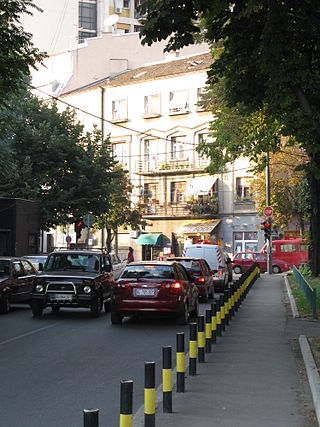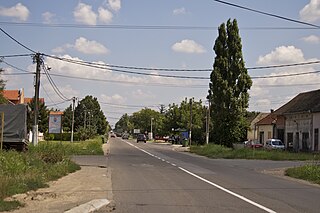Bistrica or Bistrice, from Proto-Slavic *bystrъ 'quickly flowing, rushing', may refer to:

Grocka or Grocka na Dunavu is a municipality of the city of Belgrade. According to the 2022 census results, the municipality has 82,810 inhabitants.

Surdulica is a town and municipality located in the Pčinja District of southern Serbia. As of 2011, the population of the town is around 10,000, while the municipality has 20,319 inhabitants.

Čubura, Serbo-Croatian pronunciation: [t͡ʃǔbura]) is an urban neighborhood of Belgrade, the capital of Serbia. Located in Belgrade's municipality of Vračar, it is a synonym of the city's bohemian life.

Surčin is a municipality of the city of Belgrade. As of 2022 census, it has a population of 45,452 inhabitants.

Kavadarci is a town in the Tikveš region of North Macedonia. In the heart of North Macedonia's wine country, it is home to the largest winery in Southeast Europe, named after the Tikveš plain. The town of Kavadarci is the seat of Kavadarci Municipality. Situated near Kavadarci is North Macedonia's largest artificial lake, Lake Tikveš.

FK Vlasina is a football club based in Vlasotince, Serbia.

Vlasotince is a town and municipality located in Jablanica District of southern Serbia. As of 2011, the municipality has 29,669 inhabitants, while the town itself has a population of 15,830 inhabitants.

Bogatić is a town and municipality located in the Mačva District of western Serbia. As of the 2011 census, it has 28,843 residents.

Babušnica is a town and municipality located in the Pirot District of south|eastern Serbia. According to 2011 census, the population of the town is 4,601, while population of the municipality is 12,307.

Crna Trava is a village and municipality located in the Jablanica District of southern Serbia. According to the 2022 census, the population of the village is 338 inhabitants, while population of the municipality is 1,063. This is the smallest by population and poorest municipality in Serbia.

The Vlasina is a river in southeastern Serbia, a 70 km-long outflow of the Vlasina Lake and a right tributary to the South Morava, which also gives its name to the surrounding Vlasina region.

The Morava Valley, is a general term which in its widest sense marks valleys of any of three Morava rivers in Serbia: the West Morava, the South Morava and the Great Morava. In the narrow sense, the term is applied only to the Great Morava Valley. The Serbian term follows the general manner of coining river valley names in Serbian using the prefix po- and suffix -je, meaning literally "(land) along the Morava". Morava valley lies in the central Balkans, at the crossroads which lead eastwards, towards the Black sea and Asia Minor, and further south, down the Vardar river into the Aegean sea.

Vlasina Lake is a semi-artificial lake in Southeast Serbia. Lying at an altitude of 1,211 metres (3,973 ft), with an area of 16 square kilometres (6.2 sq mi), it is the highest and largest artificial lake in Serbia. It was created in 1947–51 when the peat bog Vlasinsko blato was closed off by a dam and submerged by the waters of incoming rivers, chiefly the Vlasina.

Carska Bara is the largest individual bog in Serbia, in the municipality of Zrenjanin. Along with the neighboring pond of Stari Begej it forms the Special nature reserve "Carska Bara".

Zaovine Lake is an artificial lake in central-west Serbia, on the Tara Mountain. It was created on the Beli Rzav river as a reservoir for the Bajina Bašta II reversible hydro power plant. The lake, with its five bays, have been nicknamed the "Jewel of Tara".
Kalna is a small village in the Crna Trava municipality of the Jablanica District of Serbia.
Majdan is a village in the municipality of Gornji Milanovac, Serbia. According to the 2002 census, the village has a population of 513 people.

The Southern and Eastern Serbia is one of five statistical regions of Serbia. It is also a level-2 statistical region according to the European NUTS. It was formed in 2010. As of 2022 census, the region has a total of 1,406,050 inhabitants.

The Uvac Special Nature Reserve is a special nature reserve of the category I in Serbia. It is known for the successful project of the preservation of the griffon vulture.

















